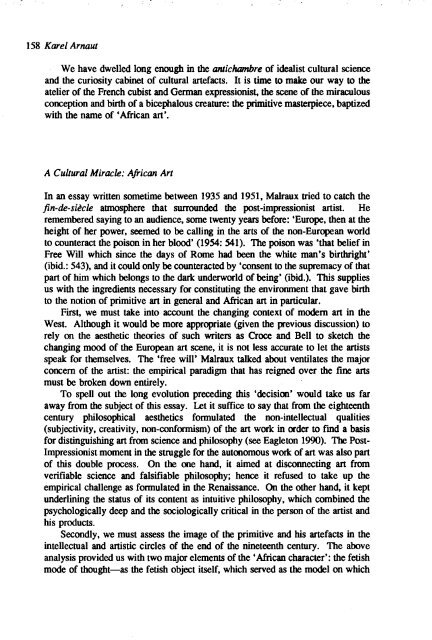1991 No. 1 CONTENTS - Institute of Social and Cultural ...
1991 No. 1 CONTENTS - Institute of Social and Cultural ...
1991 No. 1 CONTENTS - Institute of Social and Cultural ...
You also want an ePaper? Increase the reach of your titles
YUMPU automatically turns print PDFs into web optimized ePapers that Google loves.
158 Karel Arnaut<br />
We have dwelled long enough in the anlichombre <strong>of</strong> idealist cultural science<br />
<strong>and</strong> the curiosity cabinet <strong>of</strong> cultural artefacts. It is time to make our way to the<br />
atelier <strong>of</strong> the French cubist <strong>and</strong> Gennan expressionist, the scene <strong>of</strong> the miraculous<br />
conception <strong>and</strong> birth <strong>of</strong> a bicephalous creature: the primitive masterpiece, baptized<br />
with the name <strong>of</strong> 'African art'.<br />
A <strong>Cultural</strong> Miracle: African Art<br />
In an essay written sometime between 1935 <strong>and</strong> 1951, Malraux tried to catch the<br />
fin-de-siecle atmosphere that surrounded the post-impressionist artist. He<br />
remembered saying to an audience, some twenty years before: 'Europe, then at the<br />
height <strong>of</strong> her power, seemed to be calling in the arts <strong>of</strong> the non-European world<br />
to counteract the poison in her blood' (1954: 541). The poison was 'that belief in<br />
Free Will which since the days <strong>of</strong> Rome had been the white man's birthright'<br />
(ibid.: 543), <strong>and</strong> it could only be counteracted by 'consent to the supremacy <strong>of</strong> that<br />
part <strong>of</strong> him which belongs to the dark underworld <strong>of</strong> being' (ibid.). This supplies<br />
us with the ingredients necessary for constituting the environment that gave birth<br />
to the notion <strong>of</strong> primitive art in general <strong>and</strong> African art in particular.<br />
First, we must take into account the changing context <strong>of</strong> modem art in the<br />
West. Although it would be more appropriate (given the previous discussion) to<br />
rely on the aesthetic theories <strong>of</strong> such writers as Croce <strong>and</strong> Bell to sketch the<br />
changing mood <strong>of</strong> the European art ~ne, it is not less accurate to let the artists<br />
speak for themselves. The 'free will' Malraux talked about ventilates the major<br />
concern <strong>of</strong> the artist: the empirical paradigm that has reigned over the fine arts<br />
must be broken down entirely.<br />
To spell out the long evolution preceding this 'decision' would take us far<br />
away from the subject <strong>of</strong> this essay. Let it suffice to say that from the eighteenth<br />
century philosophical aesthetics formulated the non-intellectual qualities<br />
(subjectivity, creativity, non-conformism) <strong>of</strong> the art work in order to find a basis<br />
for distinguishing art from science <strong>and</strong> philosophy (see Eagleton 1990). The Post<br />
Impressionist moment in the struggle for the autonomous work <strong>of</strong> art was also part<br />
<strong>of</strong> this double process. On the one h<strong>and</strong>, it aimed at disconnecting art from<br />
verifiable science <strong>and</strong> falsifiable philosophy; hence it refused to take up the<br />
empirical challenge as formulated in the Renaissance. On the other h<strong>and</strong>, it kept<br />
underlining the status <strong>of</strong> its content as intuitive philosophy, which combined the<br />
psychologically deep <strong>and</strong> the sociologically critical in the person <strong>of</strong> the artist <strong>and</strong><br />
his products.<br />
Secondly, we must assess the image <strong>of</strong> the primitive <strong>and</strong> his artefacts in the<br />
intellectual <strong>and</strong> artistic circles <strong>of</strong> the end <strong>of</strong> the nineteenth century. The above<br />
analysis provided us with two major elements <strong>of</strong> the 'African character': the fetish<br />
mode <strong>of</strong> thought-as the fetish object itself, which served as the model on which
















